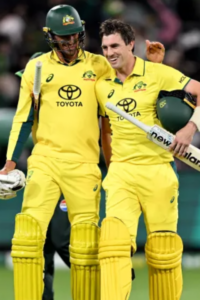
13 Years On, Pakistan Once Again Stumble Upon a Winning Formula
Pakistan have reached the final of the 2022 T20 World Cup in some style after an uninspiring start to the tournament.
Picture this. June 18, 2009, Trent Bridge. Pakistan have made the semi-finals of the 2nd edition of the T20 World Cup (then known as the ICC World T20 – because cricket loves its jargon). Pakistan started off the tournament in inglorious fashion, getting trounced by England by 48 runs in a hapless performance. Now you would think that losing to England is not something to be embarrassed about, but this was nothing like the white-ball machine we know England to be today, but quite the opposite. They had only just lost to the Netherlands a few days prior. However, the format of the tournament was kind to Pakistan, and they needed to beat the Dutch by a healthy margin to make it through, as the top 2 out of 3 teams in the group would make it through to the Super 8. Beat them they did, by 83 runs for good measure.
Now, T20s were still very much in their infancy, and Pakistan came out of the inaugural edition well-positioned to be at the forefront of innovation in the format. However, come 2009, and they went from having the explosive Imran Nazir up the order to opening with Ahmed Shehzad and Salman Butt, who were quite the opposite. Meanwhile, in the dugout sat Intikhab Alam, a great man manager but far from a great tactician as a coach. Starting to sound eerily familiar? It doesn’t stop there. The Super 8 stage started in the worst way possible, with a loss to Sri Lanka.
Now for many teams, this would have spelled the end, but Pakistan aren’t just any team. A major shakeup ensued before the next game, with Abdul Razzaq, one of Pakistan’s most underutilized white-ball assets, being drafted in to replace the “injured” Sohail Tanvir just in time for what was a do-or-die game. Moreover, they decided to pair Kamran Akmal with another hard-hitting opener in Shahzaib Hassan, with the view of taking full advantage of the powerplay, something their previous combinations had struggled to do. The New Zealand game was more so the Umar Gul show, with then record-breaking figures of 5-6 making quick work of the Black Caps. A straightforward win against Ireland in the next game (felt good two years on from 2007) meant Pakistan made the semi-finals, which is where the real innovation began.
Took a while to get here but this time, let’s really picture Trent Bridge on that day. Put in to bat first, Pakistan lost Shahzaib for a 2-ball duck. Now any other team, especially in those early days where T20s were a more condensed version of ODIs, would stick to the script or send someone to stabilize the innings. Pakistan sent out the mercurial Shahid Afridi, and the rest, as they say, is history. A 51 made off 34 balls set the stage for Pakistan’s bowlers to defend 149, sending Pakistan into the final.
This was a final where this time, the roles were reversed. Pakistan’s elite T20 bowling attack restricted Sri Lanka to 138. This set the stage for Afridi, once again promoted up the order to attack, scoring yet another 50 to clinch Pakistan’s first and only T20 World Cup title. Whether it was utilizing the powerplay to the fullest, having a spin enforcer, or the pacers leading from the front to lower the ceiling for the opposition, Pakistan had stumbled upon some modern-day tropes ahead of time. This is something that Hassan Cheema dives into in his article on ESPNCricinfo in quite some detail.
However, the focus of this article is how the same phenomenon has repeated itself 13 years on. While there is a core difference that the dressing room is nothing like the dysfunctional lot it was back then, there are a lot of similarities. Pakistan went into this tournament with a great pace battery, perhaps even better than the one they had in 2009. While the openers were leaps and bounds ahead in terms of consistency, there was a question mark on their intent in the powerplay. This was less excusable in 2022, where an attacking powerplay approach is something most successful T20 sides have adopted. Moreover, sending a 3rd anchor at number 3 in Shan Masood doubled down on this conservative approach. To put things into context, here are the powerplay strike rates of all the top 3 options Pakistan have utilized in T20Is in 2022, heading into the World Cup (minimum 5 innings).
| Batsman | Powerplay SR |
| Babar Azam | 115.4 |
| Muhammad Rizwan | 111.4 |
| Shan Masood | 81.7 |
| Fakhar Zaman | 100.0 |
Where Pakistan’s top order had lacked in strike rate, however, it had made up for with consistency in the last two years. But this World Cup brought about the first real lean patch in Babar and Rizwan’s opening partnership. The real shocker in all of this was that the middle order, especially Iftikhar Ahmed, stepped up. The rationale for selecting him was pretty much the fact that he was the only player in this squad apart from Babar, who had a good T20 record in Australia, having been on the forgettable tour at the back end of 2019.
While the first loss to India was more down to being a pacer short, the second one to Zimbabwe was the first real letdown by the pair. Chasing a paltry 131, Pakistan faltered. In a type of chase that had become Riz-Bar’s trademark over the last two years, they failed to get going. While the team recovered, a collapse at the death saw Pakistan lose from a position of needing 3 off 3. Cue the first similarity; Pakistan once again on the brink of elimination. Did I mention we have Saqlain Mushtaq in the dugout? Great man manager, but a great tactician he is not. You would be hard-pressed to think why there are not many movies about Pakistan cricket; no other country has consistently churned out such scripts.
Pakistan’s bowling, on the contrary, could stake a claim to be the best in the world at this format, particularly the pace battery. To put that into context, here are what their economies look like in each phase during the current T20 World Cup.
| Bowler | Powerplay | Middle Overs | Death Overs |
| Shaheen Shah Afridi | 5.18 | 7.33 | 6.83 |
| Naseem Shah | 5.55 | 7.50 | 5.86 |
| Haris Rauf | 6.75 | 7.20 | 7.25 |
| Muhammad Wasim Jr. | 7.67 | 4.80 | 8.00 |
After a win against the Netherlands (oh look, yet another familiar character), Pakistan still found themselves on the brink of elimination. This time, the South African act came about in the group stage and not the semi-finals. But the patterns were all the same. Pakistan’s hand was forced by Fakhar Zaman going down with an injury after just coming back. In came Mohammad Haris, who was playing just his 2nd T20 for Pakistan. After another failure by Rizwan, Haris came out all guns blazing, with a quickfire 28 off 11 at a strike rate of 254. This was a type of impetus at the top of the order that Pakistan had not seen in years, and just like in 2009, Pakistan had flipped their own script for the better.
Another happy coincidence was that Pakistan’s early collapse against South Africa meant the arrival of Shadab Khan at the 12-over mark, allowing him to take on Tabraiz Shamsi, although his taking on Anrich Nortje was a pleasant surprise, putting up a match-winning 50. Iftikhar Ahmed also took the attack to the South Africans after initially stabilizing the batting following the collapse. The quality of the bowlers then shone through, leading Pakistan to the win.
On the final day of the group stage, it was still a stretch that Pakistan would qualify, needing a favor from either the Netherlands or Zimbabwe. The former pulled through, leaving Pakistan with a straightforward equation to qualify – beat Bangladesh. That is exactly what they did, with Shaheen Shah Afridi and Shadab Khan leading with the ball before Mohammad Haris delivered another beautiful knock to see Pakistan through.
Come November 9, 2022. The second act to Trent Bridge had finally arrived. In Sydney, Australia, of all places. A World Cup in Australia is never something that inspires much hope, although Pakistan cricket’s finest moment occurred in the same setting 30 years ago. Pakistan were faced with the reliable and well-oiled machine of New Zealand. Once again, they entered a tournament where no one gave them a chance, but they still made it through to the semi-finals, topping their group.
Unlike in 2009, they were sent in to bowl first. However, once again, their bowlers put them on the front foot. Shaheen Shah Afridi, who slowly but surely had worked himself up to his optimal levels, struck with the new ball, and the remainder of the pace battery just built on that. Even the spinners chipped in, with Nawaz getting the crucial wicket of Glenn Phillips. A chase of 153 was made to look easy, with Pakistan once again flipping their own script.
Rather than take it deep and put the onus on the finishers to cover up the scoring rate, Babar and Rizwan, both of whom had struggled till this point, decided to break the chase in the powerplay itself. They attacked every bowler put in front of them, amassing 55 in the powerplay at a run rate of 9. This was not just by Pakistan’s standards, but by any standard, a great powerplay. Babar and Rizwan had embraced another modern T20 trope, one Pakistan had innovated but somehow left behind, and they reaped the rewards. This set the rest of the chase up to be straightforward as Pakistan booked their date with destiny in the final at the MCG, the setting where they reached the highest of highs in 1992. If we haven’t had enough historical parallels, this time, they face England, the same opposition they had at the same venue in 1992.
Parallels set aside, Pakistan have once again, just like in 2009, stumbled upon tactical brilliance. Watching the last three games, one would not think that this is a team that is out of touch with the modern game, far from it. Pushed against the wall, they have always innovated, and that innovation has more often than not bore fruit, whether that be 2009 or 2017. Now one can only imagine what a daunting beast they can become for world cricket if this fearless approach is carried through beyond the World Cup, regardless of the outcome on Sunday. The final will be one that will test Pakistan, but if there’s one thing we know, once the Pakistani machine gets going, stopping it is something even the best find impossible.







Leave a Reply